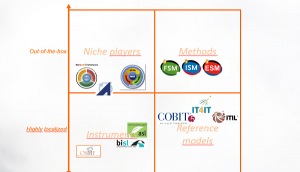On ITIL, VeriSM, IT4IT, ITCMF, practices and principles…
Although the interest in ITIL is declining on a global scale, AXELOS (the owner of ITIL) is still acting as before: a new version of ITIL will be launched in Q1 2019 and this new version is ready to support you in coping with the “Fourth Industrial revolution”. Quite a statement. And it’s now again identified with a number (‘4’) instead of a year (‘2019’) – something they said they wouldn’t do again…
This new ITIL version is “best practice” again, instead of just “good practice”. As AXELOS says: “Research has confirmed that ITIL remains best practice for the ITSM industry“. They know this, even before ITIL 4 has been developed and published.
This means that the announced update of ITIL was postponed at least half a year. The core elements will remain the same and all current certifications will continue to be recognized. This implies that ITIL 4 will only cover extensions. The new version says it will include practical guidance on how practices such as DevOps, Agile and Lean are associated with ITIL. But wasn’t that the claim that was already made by VeriSM, half a year ago?
And have they learned from the past? AXELOS now says they have a “Team of Lead Architects” instead of just one Lead Architect. That sounds like a reward system for the involved individuals: “I am a Lead Architect for ITIL, hire me”. And instead of a select team of senior experts, they now have “The ITIL Development Group”, covering more than 2,000 members and they’re asking for even more. Ever tried to produce a book with more than 100 participants? I can assure you that this either leads to one hell of a job, or to ignoring their contributions. Unless they simply don’t contribute, of course. AXELOS claims to already have a group of participants of >2,000, so that may explain part of the delay. Anyway, the new approach yells ‘practice’ all over.
And what about IT4IT?
Launched in 2015 by the Open Group, based on the HP & Accenture repository, it delivered a full-blown practice-based framework, like the ones we know from ITIL and COBIT. Was IT4IT the next threat to the IT market? The horribly complex ”reference architecture” seems to emphasize the vendor business model of complexity once again. Announced as a “game changer” at its launch, it is hardly heard of any more. More on IT4IT: here.
And what’s happening to VeriSM, in the mean time?
VeriSM was launched at the end of 2017, as an alternative approach, based on existing “best practices”. It immediately created a series of books, consultancy profiles, training programmes and exams – completely analogous to the business stategy of AXELOS, but with a set of business partners that was chased away by AXELOS in it’s effort to boost ITIL turnover with just one exam partner. After an overwhelming flood of attention in the first months of 2018, it seems to slow down a bit now, as people are asking the big question “what help does VeriSM bring me as a practitioner?”. The answer seems to be more in terms of “understanding how to approach and apply various existing best practices”, than in terms of providing specific support that wasn’t already covered elsewhere. This actually holds a promise of a bit more “principle” than the traditional practice-based approaches, but unfortunately VeriSM doesn’t deliver the solution with that promise: it remains with a high-level analysis of options to be used for a service management architecture, but it doesn’t deliver the architecture itself. Read more on VeriSM.
And IT-CMF, the product of the Innovation Value Institute?
Offering an integrated management toolkit, covering more than 30 management disciples, with organizational maturity profiles, assessment methods, and improvement roadmaps for each, this academic product may be considered a well-kept secret. It’s used within large organizations, it’s very practical, and it leans on more than just best practices. But again, IT-CMF offers predominantly practice support, be it on a more strategic level than the frameworks I mentioned above. Read more on IT-CMF here.
Practices or principles?
All of these frameworks still lean heavily on practices. Promoted by consultancy firms and supported by tool vendors, they illustrate a focus on where the current problems are felt, i.e. where their money is made. Solutions are always fitted into terms of provider offerings, not in terms of organizations learning to manage their own business in better ways. This approach is predominantly executable.
This is opposite to recent strategies followed in the Netherlands, where methods are gaining traction. These methods support principle-based strategies that aim for improving the control capabilities of organizations, by stimulating a self-learning path based on the understanding and application of management systems that follow a clear service management architecture. These approaches are predominantly learnable and they enable a well-considered application of a wide array of practices (from the popular frameworks).
These methods are still low in volume, as they do no provide an easy business model for supporting vendors: the focus is on improving the customer’s capabilities, and the result of that strategy is likely to end the provider’s turnover rather sooner than later. Nevertheless, more and more organizations are adopting these method-based approaches, as they obviously add value in a much simpler and more sustainable way than the traditional complexity-based offerings of the “ITIL industry”.
The method-based approaches have some very critical benefits over the traditional practice-based approaches:
- The organization invests in its own capabilities, climbing up the value-based maturity ladder.
- The level of control is accelerating, enabling the organization to save themselves better and better.
- Services can better be aligned to customer’s requirements, as the organization is more in control of its own service delivering capabilities.
- Tools can better be aligned to operational requirements, as the organization is more in control and it has more of a service management architecture in place.
- It saves the organization “a bundle”, as they don’t have to hire or buy external resources at the traditional level any more.
It may be clear that – as long as vendor strategies are the dominant forces for innovation of service management strategies – only customers that have strong leadership in place, will be able to profit from these method-based strategies.

 The Netherlands are way ahead of other countries in terms of systematically and methodically improving service organizations – at least that’s what I think.
The Netherlands are way ahead of other countries in terms of systematically and methodically improving service organizations – at least that’s what I think.

